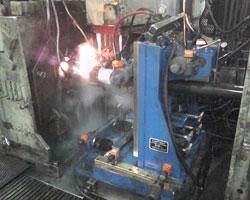- FMA
- The Fabricator
- FABTECH
- Canadian Metalworking
Categories
- Additive Manufacturing
- Aluminum Welding
- Arc Welding
- Assembly and Joining
- Automation and Robotics
- Bending and Forming
- Consumables
- Cutting and Weld Prep
- Electric Vehicles
- En Español
- Finishing
- Hydroforming
- Laser Cutting
- Laser Welding
- Machining
- Manufacturing Software
- Materials Handling
- Metals/Materials
- Oxyfuel Cutting
- Plasma Cutting
- Power Tools
- Punching and Other Holemaking
- Roll Forming
- Safety
- Sawing
- Shearing
- Shop Management
- Testing and Measuring
- Tube and Pipe Fabrication
- Tube and Pipe Production
- Waterjet Cutting
Industry Directory
Webcasts
Podcasts
FAB 40
Advertise
Subscribe
Account Login
Search
Taming two weld beads
Handling a pair of red-hot, razor-sharp scarf strands at once
- By Eric Lundin
- June 8, 2012
- Article
- Tube and Pipe Production
Many tube and pipe mill operators, or maybe all of them, would agree that handling scarf is one of the most demanding tasks they have. The weld bead is red-hot, and when the scarfing tool peels it off the weld seam, whether it’s from the ID or OD, it becomes razor-sharp. Mill speeds have increased over the decades, and so has the speed at which the scarf comes off the tube.
Equipment manufacturers offer two ways to deal with the strands of OD scarf: winding and chopping. Winding it up on a powered take-up reel is the conventional way to handle it; chopping it into short lengths is the newer of the two methods. While both have advantages, neither eliminates the risks associated with handling a hot, sharp strand of steel that relentlessly feeds off the mill.
While it’s unlikely that a future technology will ever eliminate scarfing hazards—the stringer will always be a hot, sharp strand of metal in motion—two relatively recent developments help reduce operator exposure to the weld beads that come off of medium- to large-diameter tube and pipe.
Working on the OD
“Almost everyone does OD scarfing,” said John Seminew, founder of Similcut LLC, a manufacturer of custom-made scarf choppers. The conventional way to remove OD scarf is to feed it to a powered winder. When the winder is full, the mill operator stops the winder, cuts the strand, removes the ball of scarf from the winder, and drops it into a bin. The operator has to do this quickly because the mill is still running and scarf is feeding off of the tube or pipe; he needs to thread the new end into the winder and the process starts again.
It’s a hazardous job; in addition to risk of burns and lacerations, the operator is at risk for stress injuries related to lifting the ball of scarf, which can weigh up to 90 lbs., and tendonitis from the frequent clenching motion needed to cut the strand with tin snips and gripping motion used to lift the scarf ball. Occasionally the strand breaks, creating two new hazards: The winder continues to rotate, with a tail of scarf sticking out, and the tube mill continues to run, sending the scarf anywhere but to the winder.
“You can never turn your back on a winder,” Seminew said.
All this changed with the arrival of the scarf chopper. After starting the mill, the operator grasps the end of the strand with a pair of pliers and guides it into the chopper’s intake. The chopper then cuts the continuous ribbon into manageable lengths.
For OD scarfing, Seminew’s development is a self-feeding chopper. After the unit is lowered into place, it begins scarfing the pipe and the stringer feeds directly into the chopper. The blade activates every few seconds, chopping off a short length (6 to 10 in., depending on the setting and line speed) that drops onto a magnetic conveyor and is carried away from the weld area.
A Look Inside
ID scarfing isn’t nearly as common as OD scarfing.
“ID scarfing depends on the product,” Seminew said. “Pipe made to API standards and other pipe made to carry liquids usually require ID scarfing.”
Compared to OD scarf, ID scarf should be easier to handle because it’s inside the tube or pipe and its movement is restricted. In fact, ID scarfing is the trickier of the two processes. Ideally, ID scarf twists and curves slightly, forming a gently bending ribbon of steel inside the hollow. In reality, it often develops kinks and knots, forming a so-called “bird’s nest” inside the pipe, and removing it can be a time-consuming and messy job.
“It’s difficult because you can’t see it,” Seminew said. “When you’re making large-diameter pipe, you might have to walk 300 feet to the end of the line to take a look inside the tube to see what’s going on.”
Adjustments and Maintenance. The scarfing tool requires frequent adjustment to change the cut depth. Manufacturing tube is anything but a constant, predictable process. Tool wear, a change in the raw material’s hardness, drifting welder power caused by line current fluctuations, or any other unintended change in the multitude of variables on a mill can alter the cut depth, requiring the operator to make an adjustment to compensate.
“Most ID scarf toolholders have wheels,” Seminew said. “The wheels contact the bottom of the tube’s ID and the scarfing tool contacts the top of the tube’s ID. The operator raises or lowers the wheel to adjust the tool’s cutting depth.”
“To make an adjustment, the operator has to stop the mill, then usually cuts a hole in the bottom of the tube to drain the coolant,” said Dan Ventura, a former mill operator, currently president of Ventura & Associates, an engineering consulting firm. “Then he has to cut a window in the top of the tube to get access to the toolholder. The tube is hot, there’s a strand of red-hot scarf in there, and the operator can’t wear gloves because he’s trying to adjust some tiny set screws.”
The wheel itself can be troublesome. The ID of a tube or pipe on a weld mill is an extreme environment—it’s hot, a strand of scarf is snaking around in there somewhere, and it’s drenched in coolant—so the wheel doesn’t last long and must be replaced periodically.
Cutting and Removing the Stringer. In past years most tube and pipe mills used a friction saw to cut the tube or pipe and the stringer; this limited the stringer’s length to the pipe length. These days many mills use carbide-tipped saw blades on a saw that orbits the tube or pipe, cutting through the wall but no farther. By not cutting through the ID, the blade avoids the stringer, preventing damage to the saw’s teeth. The operator has to clip the stringer manually.
Chop It. For chopping ID scarf, Similcut’s design is a cantilevered arm without a wheel. It’s adjustable from the stand, eliminating the need to open the workpiece to adjust the cut depth. Some models are equipped with a camera so the operator can see how deep the scarfing tool is cutting into the tube wall. The operator can adjust the cut depth to the right depth on-the-fly. It also chops the stringer into pieces, preventing the dreaded bird’s nest.
Limitations
ID scarf chopping has limitations. Similcut’s smallest design works in tube or pipe with a 3.5-in. ID; for sizes smaller than 3.5 in., a conventional toolholder is the way to go. Furthermore, chopping the ID strand doesn’t remove all the hazards and hassles. Whether the stringer is continuous or in pieces, it must be removed in a subsequent flushing step. The common method is a blast of water under high pressure sent through the tube. As the wave of water exits the far end, it brings the stringer (or stringers) with it. A backstop, usually made from plywood, stops the forward momentum; the stringer hits the floor and the water goes everywhere.
Finally, Similcut equipment isn’t available off-the-shelf.
“On all cantilevered arms, the scarfing tool must be in the proper position relative to the weld head,” Seminew said. “The arm also has to hold the impeder, which must be at the proper location relative to the weld rolls. Each installation is a custom installation.” An order can take up to four months from the time the purchase order is cut until the unit ships.
These limitations have to be weighed against the reduced exposure to hazards; the convenience of seeing inside the tube to accurately set the cut depth; the ease of changing the cut depth; and the ability to change the cut depth on-the-fly.
About the Author

Eric Lundin
2135 Point Blvd
Elgin, IL 60123
815-227-8262
Eric Lundin worked on The Tube & Pipe Journal from 2000 to 2022.
About the Publication
Related Companies
subscribe now

The Tube and Pipe Journal became the first magazine dedicated to serving the metal tube and pipe industry in 1990. Today, it remains the only North American publication devoted to this industry, and it has become the most trusted source of information for tube and pipe professionals.
start your free subscription- Stay connected from anywhere

Easily access valuable industry resources now with full access to the digital edition of The Fabricator.

Easily access valuable industry resources now with full access to the digital edition of The Welder.

Easily access valuable industry resources now with full access to the digital edition of The Tube and Pipe Journal.
- Podcasting
- Podcast:
- The Fabricator Podcast
- Published:
- 04/16/2024
- Running Time:
- 63:29
In this episode of The Fabricator Podcast, Caleb Chamberlain, co-founder and CEO of OSH Cut, discusses his company’s...
- Trending Articles
Team Industries names director of advanced technology and manufacturing

Orbital tube welding webinar to be held April 23

Chain hoist offers 60-ft. remote control range

Push-feeding saw station cuts nonferrous metals

Corrosion-inhibiting coating can be peeled off after use

- Industry Events
16th Annual Safety Conference
- April 30 - May 1, 2024
- Elgin,
Pipe and Tube Conference
- May 21 - 22, 2024
- Omaha, NE
World-Class Roll Forming Workshop
- June 5 - 6, 2024
- Louisville, KY
Advanced Laser Application Workshop
- June 25 - 27, 2024
- Novi, MI





























